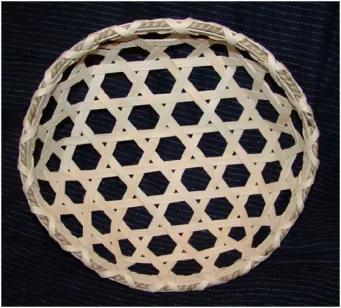How Do You Make a Cheese Shaker Style Basket

Learn to weave this beautiful Shaker style cheese basket at the workshop on March 31st.
This Saturday, March 31st at 12pm, the Shaker Heritage Society is hosting a basket making workshop led by local basket weaving instructor Sandy Salada. At the end of this four hour workshop, participants will take home a beautiful Shaker style cheese basket. The large hexagonal weave was used for draining cheese curds, but today it can serve a variety of purposes or as a beautiful decorative piece. Basket making is a long tradition in many cultures, and the Shakers started weaving baskets quite early in their history.
It is thought that the Shakers began weaving their own baskets when those purchased from local Native Americans couldn't meet their needs. Most Native American baskets were made from lightweight splint that wasn't highly durable; the Shakers were using baskets for every day agricultural work and needed something that could withstand this heavy usage. Their earliest baskets were rustic and tough. Function, not design, was the main concern. Their early pieces were inspired heavily by the techniques and designs of European settlers in New England and northeast Native American tribes. It wasn't until later that the fine basketry developed that the Shakers were known for.
Like most of their industries, the Shakers adapted available technology to create a more efficient manufacturing process that increased the basket's quality. For example, rather than pounding logs manually with wooden mallets to prepare wood splint, as the Native Americans did, the Shakers adapted the mechanic trip-hammer, a blacksmith's tool, to do complete this task. These baskets were made from local wood (predominantly ash) and processed completely by the Shakers. This was a joint operation between brethren and sisters. The brethren were responsible for cutting and preparing the "basket stuff," as they called it, while the majority of the basket weaving was done by the sisters. Wooden basket molds were created to ensure uniformity and perfection in each piece.
There are two types of Shaker baskets: utility baskets and "fancy-work" baskets. Utility baskets were used for every day work. The latter was highly influenced by Victorian travelers' desires for novelty souvenirs as they journeyed to spas and resorts in New York and New England. Still, the Shakers began selling baskets to the Worlds' People as early as 1809.
The mid-19th century decline of Shaker men meant that the primary responsibility for the industry fell on the sisters. This served to feminize the design of Shaker baskets. This, combined with the new baskets now being mass produced in factories, should have been the end of Shaker basket making. The Shaker sisters persevered and the "fancy-work" basket was created. "Fancy goods" is not a Shaker term, but a Victorian one: this is what they called novelty items that they collected during travel. Mount Lebanon produced the greatest number and finest-made Shaker baskets for public sale. In the later 19th century, Shakers began adopting the Native American practice of visiting fairs and resorts to sell their goods. As Shaker numbers continued to dwindle, so did the number of baskets produced. Older veteran basket weavers were dying, and still more members were leaving the community. A huge fire at Mount Lebanon in 1875 took out several Church Family buildings, as well as a number of baskets, molds, tools, and materials. There were efforts to revive the once booming industry, but with little success.
Today, Shaker baskets are among the many items that collectors desire. The prices for Shaker baskets and poplarware have greatly increased over the past few decades. What the Shakers considered durable items necessary to complete daily work, collectors view as pieces of delicate art.
If you would like to weave your own Shaker style basket this Saturday, please call the Education Coordinator at (518) 456-7890 x23 or email shakereducator@gmail.com. This workshop is $35 and includes the cost of tools and materials. Space is limited, so be sure to reserve your spot today!
How Do You Make a Cheese Shaker Style Basket
Source: https://shakerheritage.wordpress.com/2012/03/28/the-shaker-basket-making-tradition/